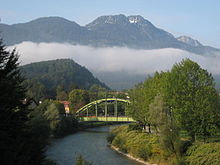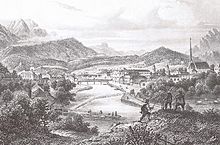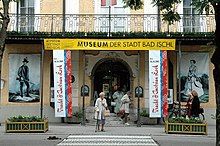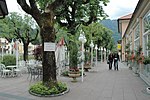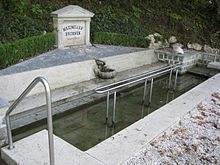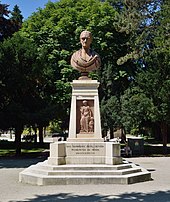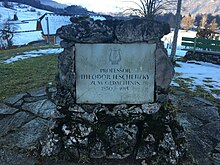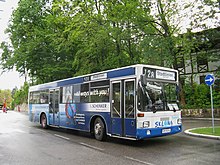Bad Ischl
|
Borough Bad Ischl
|
||
|---|---|---|
| coat of arms | Austria map | |
|
|
||
| Basic data | ||
| Country: | Austria | |
| State : | Upper Austria | |
| Political District : | Gmunden | |
| License plate : | GM | |
| Surface: | 163.06 km² | |
| Coordinates : | 47 ° 43 ' N , 13 ° 38' E | |
| Height : | 468 m above sea level A. | |
| Residents : | 14,070 (January 1, 2020) | |
| Postal code : | 4820 | |
| Area code : | 06132 | |
| Community code : | 4 07 03 | |
| Address of the municipal administration: |
Pfarrgasse 11 4820 Bad Ischl |
|
| Website: | ||
| politics | ||
| Mayoress : | Ines Schiller ( SPÖ ) | |
|
Municipal Council : (2015) (37 members) |
||
| Location of Bad Ischl in the Gmunden district | ||
| Source: Municipal data from Statistics Austria | ||
The town of Bad Ischl is an Austrian health resort with 14,070 inhabitants (as of January 1, 2020) on the Traun , in the center of the Salzkammergut in the southern part of Upper Austria . The city belongs to the Gmunden district and lies in the judicial district of Bad Ischl .
The health resort was awarded a gold medal in the competition for quality of life of the Entente Florale Europe with the highest number of points ever awarded. In 2024, Bad Ischl, along with 20 municipalities in the Salzkammergut, will be the European Capital of Culture alongside Bodø in Norway and Tartu in Estonia .
geography
Bad Ischl is located at an altitude of 468 m in Upper Austria. The extension is 19.6 km from north to south and 17.8 km from west to east. The total area is 163.06 km². 71.9% of the area is forested, 7.9% of the area is used for agriculture. The center of the village is surrounded in a semicircle by the Traun and the flowing Ischl ; the Rettenbach also flows into the Traun in Bad Ischl.
Community structure
The municipality includes the following 20 localities (population in brackets as of January 1, 2020):
- Maple (608)
- Bad Ischl (1875)
- Corner (149)
- Haiden (1634)
- Hinterstein (95)
- Jainzen (713)
- Kaltenbach (1497)
- Koesslbach (81)
- Kreutern (808)
- Lauffen (183)
- Lindau (301)
- Mitterweissenbach (112)
- Perneck (280)
- Ramsau (174)
- Reiterndorf (2563)
- Rettenbach (527)
- Roith (354)
- Quarry (459)
- Steinfeld (1008)
- Sulzbach (649)
The community consists of the cadastral communities Ahorn, Bad Ischl, Haiden, Jainzen, Kaltenbach, Lauffen , Lindau, Perneck, Reiterndorf and Rettenbach.
Neighboring communities
| Steinbach am Attersee ( Vöcklabruck district ) | Ebensee | |
| St. Wolfgang in the Salzkammergut |

|
|
| Strobl ( Salzburg ) | Bad Goisern on Lake Hallstatt | Altaussee ( Styria ) |
climate
|
Average monthly temperatures and precipitation for Bad Ischl
|
|||||||||||||||||||||||||||||||||||||||||||||||||||||||||||||||||||||||||||||||||||||||||||||||||||||||||||||||||||||||||||||||||||||||||||||||||||||||||||||||||||||||||
history
Early days
It is assumed that the Bad Ischl area was inhabited as early as the Hallstatt and Latène times. 15 BC The area became part of the Roman Empire . The presence of the Romans is documented by two inscription stones and scattered finds, one of which was lost in the 18th century, probably in the course of the church renovation. This, a consecration stone to Mithras from the period after 170, contained the reference to a statio Esc (ensis) (customs post). A Roman tombstone from the 3rd / 4th centuries was preserved. Century. Another consecration stone was found in the nearby Kienbachklamm for the Celtic / Roman god Mars Latobius . Noricum remained a Roman province for half a millennium. In the course of the great migration , the inner Salzkammergut probably experienced a noticeable decline in population, which was, however, compensated for by immigration of Bavarians and Slavs in the following period . These areas had already recovered under Charlemagne , but were thrown back again by the forays of the Hungarians.
Around the year 1000 the country, which at that time belonged to the Bavarian Mark ob der Enns , finally recovered from the destruction. The population increased noticeably, and salt production was also resumed. Through their followers, the Lords of Ort, the Styrian margraves (from 1180 dukes) from the Otakare family extended their territory to the inner Salzkammergut in the first half of the 12th century. They were inherited by the Babenbergs in 1192.
Since then, salt has once again become the most important economic factor in what is now called Ischlland.
The place was first mentioned in a document in 1262 as Iselen , later as Yschl .
High Middle Ages and the salt conflict
Than a century later, now already under the rule of the Habsburgs - the basic rule Wildenstein - a new salt mine in Goisern was discovered and released to break down, it came by the Archbishop Konrad IV. From Salzburg to open conflict to the salt monopoly .
The anger of the archbishop grew even greater when the abbot Heinrich von Admont , a Habsburg favorite, also mined salt in the Gosau valley and was busy extracting salt in Hallstatt . Having to share his salt trade seemed unbearable to the proud archbishop, so a furious battle for salt production and the salt trade broke out. The archbishop brought in a complaint in which he referred to the monopoly - supposedly only due to him. This objection was not recognized by the Habsburg Duke Albrecht I , which once again increased the anger of the archbishop. Albrecht set up fortifications in the endangered places. For example, in Hallstatt a protective station, the Rudolfsturm , was built, from which one could see the whole country far.
When the rumor arose one day that the Duke had died of the effects of poisoning, Archbishop Konrad prepared for the final extermination campaign against the newly created salt pans that he hated. He had the mining sites demolished and the associated settlements reduced to rubble. But his triumph did not last long, as Albrecht I had not died at all and was now taking revenge on the archbishop in a bloody feud.

Peace was made in 1297. This agreement ushered in an era of construction and peace. New mountains were used to extract salt. From 1419 Wildenstein Castle was the seat of the - from 1452 imperial - carers who administered the Habsburg salt trade.
The main town of the Ischlland at this time was Lauffen (first documented mention in 807, today cadastral parish of Bad Ischl), 1275/80, at the time of the Battle of Dürnkrut / Jedenspeigen in 1278, with which the Salzkammergut finally came to Habsburg , by King Rudolf I. was raised to the market (the oldest market in the Salzkammergut). For "special merits", Duke Albrecht III. 1392 special rights to the village of Ischl. Under Emperor Friedrich III. Ischl was raised to market in 1466. In 1656 the name ' Salzkammergut ' for the property around Bad Ischl was mentioned for the first time in a document.
In 1563 the Ischler Salzberg was opened up by the mine in Perneck. The Pfannhaus (Saline) on the Traun was built in 1571 (called Kolowrat brewhouse from the 19th century ). For generations of Ischlern, salt became the most important economic basis, in addition to the previous transport, now also in direct production. This means that Ischl is becoming increasingly important compared to Lauffen. In 1595 the brine pipeline was built from Hallstatt via Goisern to Ischl, in 1604/7 the brewing hut Ebensee with an extension of the brine pipeline.
Reformation and Counter Reformation
In the 17th century, membership in Protestantism had to be bitterly fought for. Lutherans who immigrated from Salzburg had to renounce their religion in the course of the Counter Reformation . Anyone who opposed the order was imprisoned or even executed. Many Protestants, as originally Schloss Pernegg local barons of Racknitz , left Austria. Protestantism could be suppressed by force for about 100 years until the movement openly demanded its right to freedom of worship. The request was rejected and the rebellious Protestants were asked to either convert to Catholicism or to emigrate to Hungary and Transylvania (see Landler ). Since most of the affected families had lived in the Salzkammergut for generations, the majority of Lutherans stayed in the country and swore - at least outwardly - from their belief. But it was only a matter of form, because in truth they continued to practice their religion secretly ( cryptoprotestantism ) until Emperor Joseph II finally officially allowed Protestantism with the introduction of the tolerance patent in 1781.
Health resort and "imperial city"

Ischl's heyday began in the 19th century, despite its economic significance. In 1821 the Viennese doctor Franz Wirer came to Ischl and found out about the successes of the saline physicist Josef Götz, who had been testing the effects of brine baths on sick saline workers since 1807. The first about 40 (foreign) spa guests appeared in 1822. In the following year, the number of guests doubled. 1823 can be seen as the actual founding year for the first Ischl spa as a brine bath. The brine bathing room ( Tänzelbad ) built by the saline cashier Michael Tänzl in his house on the Traun had to be expanded as early as 1825.
Ischl soon rose to become a health resort of European importance. The number of guests who came to Ischl - including State Chancellor Metternich and Archduke Rudolf - grew steadily. In 1827 the archducal couple Franz Karl and Sophie , the parents of the future Emperor Franz Josef, took a cure here for the first time. In 1827/1828 Franz and Magdalena Koch built the Posthof (Gasthof zur Post), the first hotel in the Salzkammergut.
The high point of Ischl's heyday was the period from 1849 to 1914 as the imperial summer residence under Emperor Franz Joseph I. In 1853, Franz Joseph became engaged to Elisabeth (Sisi) in Bavaria in what was then the Seeauerhaus , which is now the museum of the city of Bad Ischl.
Since the summer of 1863, the important composer Anton Bruckner has always come to Ischl for the Emperor's birthday and for other festive occasions of the imperial family as court organist. Bruckner liked to describe himself as "the emperor's organist". On July 31, 1890, at the wedding of Archduchess Marie Valerie and Archduke Franz Salvator, he played variations on the imperial anthem on the organ , combined with the Hallelujah from the Messiah by Georg Friedrich Handel . Then Bruckner was invited to dinner at the Hotel Post . On August 2, 1890, Bruckner gave his own organ concert. He often visited his friend Attwenger. A plaque on the parish church commemorates Bruckner's stays. There is also an entry by Bruckner in the guest book of the Zauner confectionery .
Ischl was the summer residence of many other popular composers, above all Johann Strauss , Franz Lehár and Johannes Brahms , but other musicians from the turn of the century also regularly spent the summer here; many of them were also looking for proximity to the local court. This is how Ischl developed into a meeting place for artists of international renown during the time of the Danube Monarchy. Even today, operetta weeks are held every year during the summer months in the Kurhaus. Important writers like Mark Twain , Theodor Herzl and Franz Werfel also stayed in Ischl.
In 1906 Ischl was renamed Bad Ischl .
On July 28, 1914, Emperor Franz Joseph wrote the Manifesto To My Peoples in the Imperial Villa in Bad Ischl ! in which he declared war on the Kingdom of Serbia . This should be the beginning of the First World War .
After the end of the monarchy
In 1920 Bad Ischl was given the name of health resort by the state government .
After the July coup, the Nazi activists Franz Unterberger and Franz Saureis were arrested in Bad Ischl for possessing explosives. They were found guilty at the trial in the Vienna Regional Criminal Court , sentenced to death on August 20, 1934 , and executed . During the National Socialist era , they were honored with an honorary grave in the Bad Ischl cemetery .
In 1940 Bad Ischl was promoted to town .
From February to December 1942, there was a satellite camp of the Dachau concentration camp in Bad Ischl .
After the end of the Second World War in 1945, Bad Ischl belonged to the American zone of occupation in occupied post-war Austria . A DP camp was set up by the American military administration to accommodate so-called displaced persons . The camp was managed by UNRRA .
Population development
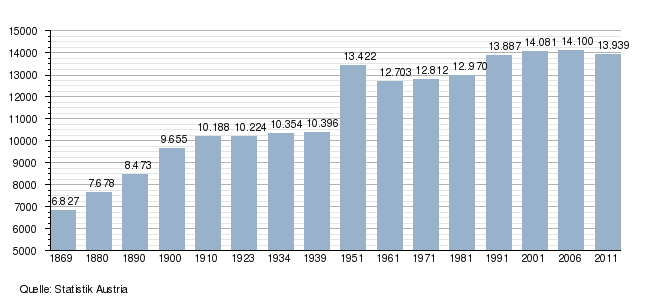
politics
The city council (city government) consists of nine members. The mayor, who is directly elected by the population, chairs the city council. The two vice mayors and the city councilors are elected by the municipal council, whereby the division of responsibilities is also determined by the municipal council.
- The city council is composed as follows:
- The municipal council is composed as follows (as of 2015):
- SPÖ 18 mandates, ÖVP 8 mandates, FPÖ 8 mandates, Greens 3 mandates.
- mayor
- 2007–2019: Hannes Heide (SPÖ)
- since 2020: Ines Schiller (SPÖ)
On December 11, 2019, Hannes Heide announced his retirement as mayor at the end of 2019. On January 2, 2020, the municipal council elected his partner, Ines Schiller, as his successor.
Town twinning
-
 Opatija , Croatia (since 2011)
Opatija , Croatia (since 2011) -
 Getterle , Hungary (since 2013)
Getterle , Hungary (since 2013) -
 Sarajevo , Bosnia-Herzegovina (since 2015)
Sarajevo , Bosnia-Herzegovina (since 2015)
coat of arms
Blazon: In gold a black three-mountain, on the middle and rear crest of which a black chamois stands; on the front an ash tree with green leaves. The community colors are black-gold-green.
Ischl was given the market coat of arms in the 15th century by Emperor Friedrich III. awarded. Since the original document was destroyed in a fire in 1490, the coat of arms of Emperor Maximilian I was confirmed again in 1514.
The chamois suggests big game hunting in the nearby mountain areas and the tree is said to be reminiscent of the former large ash forest in the Ischler Valley.
Culture and sights
The townscape of Bad Ischl is characterized by buildings of historicism , especially from the Wilhelminian era . The city is also called "Imperial City" in memory of Emperor Franz Joseph. Bad Ischl is a member of the Association of Small historic towns .
Museums
- Kaiservilla and Kaiserpark : former summer residence of Emperor Franz Joseph I.
- Bad Ischl City Museum: in the former Hotel Austria
- Lehár Villa : the former estate of Franz Lehár
- Museum of Vehicle Technology and Aviation
- Photo museum in the Marmorschlössl : the Marmorschlössl is the former tea house of Empress Sisi
- Ischlerbahn open-air museum
- Haenel Pancera Family Museum
Sacred buildings
- Parish church of St. Nikolaus : mentioned in a document in 1344, tower from 1490, nave 1771–1780, frescoes by Georg Mader (1877), altar paintings by Leopold Kupelwieser (1847–1851)
- Evangelical parish church : built 1874–1879
- Kalvarienbergkirche : built 1704–1706, expanded in 1779
- Kreuzkapelle am Traunkai, built in 1726
- Parish church Maria an der Straße : in Pfandl, built 1956–1958
- Parish Church of the Assumption : in Lauffen, built in the 15th century
- Cemetery : laid out in 1719, expanded several times, with resting places of important personalities such as Leopold Hasner , Franz Lehár , Leo Perutz , Richard Tauber (memorial stone, Richard Tauber found his final resting place in the London cemetery Brompton), Oscar Straus , Hilde Spiel (the gravestone is called she as Hilde Maria Flesch-Brunningen)
Secular buildings
- Former Hotel Elisabeth (formerly Hotel Tallachini ): opened in 1844
- former Hotel Post :
- former brewhouse or pancake house ( Kolowrat brewhouse ): built in 1834
- Kongress & Theaterhaus : built 1873–1875
- Lehár-Filmtheater ( Lehartheater )
- New Kurhaus / Kurmittelhaus (today: Eurotherme Bad Ischl )
- Plaßmühle (Niedermühle): first mentioned in a document in the 15th century, built between 1599 and 1607. Three-winged building with galleries. 1639 Free seat of Zacharias Plaß von Mühlleiten, after whom the Niedermühle has been named since then.
- Bräu Griebl cellar house
- Post office building: built in 1895
- Sophiens Esplanade: built around 1830, extended in 1869
- Trinkhalle : built by Franz Lössl from 1829 to 1831 , listed as a historical monument
- Villa Seilern : built in 1881, owned by the teacher's health insurance fund, hotel operation
- Villa Blumenthal : On the road to Lauffen, shown at the 1893 World's Fair in Chicago . The building made of American pitch pine was dismantled and rebuilt in 1895 by Oskar Blumenthal in Kaltenbachau. It is therefore also known as the “ancestor of the prefabricated house”.
- Old Ischlerbahn Bridge: demolished in 2007
Other structures
- Zauner : famous former imperial court - confectionery
- Café Ramsauer: in operation since 1826
- Wildenstein castle ruins
Monuments
- Franz Karl Fountain (1881)
- Hasner Memorial (1893)
- Kaiser hunting statue, unveiled in 1910, created by Georg Leisek (1869–1936)
- Kaiser-Franz-Joseph-Kreuz, erected on the Katrin in 1910
- Lehár monument (1958)
- Leschetizky Monument
- Maria Louisen Spring (1840)
- Maximilian Fountain: Erected in 1868 in memory of Ferdinand Maximilian of Austria , the Emperor of Mexico who was executed in 1867
- Onderdonk Fountain (1951)
- Rudolfs Monument (1839)
- Stelzhamer monument
- Dr. Franz Wirer monument: (1839), founder of the first brine bath in Bad Ischl
Natural monuments
- Hohenzoller waterfall
- Hoisenradalm
- Katrin -Alm the hangover Mountains
- Rettenbachalm
- Siriuskogl with Einsiedlerstein and observation tower
Regular events
- Celebrations for the Emperor's Birthday: Every year on August 18, the birthday of Emperor Franz Joseph I is commemorated. The program includes an extensive parade of historical regiments from all over the former monarchy and a St. Mass in the parish church, which is filled to the last seat, in the presence of high-ranking representatives from politics and the church and members of the House of Habsburg-Lorraine . The imperial mass, which traditionally ends with the singing of the imperial hymn God receives , was celebrated in 2015 by the Latin Patriarch of Jerusalem , Fouad Twal .
- Emperor's festival of the Bad Ischl Citizens' Chapel on the Esplanade: every 15 August
- Emperor's stroll in the city center: on August 17th every year
- Imperial mass in the parish church: on August 18th
- Kaiserlauf : annually in September
- The Liachtbratlmontag is a local holiday in Bad Ischl and has been listed as part of the intangible cultural heritage of Austria in the national register of UNESCO since 2011 .
-
Glöcklerlauf : every year on January 5th
 Glöckler in Ischl, 2006
Glöckler in Ischl, 2006 - Forest bird exhibition as part of the 2010 UNESCO cultural heritage Salzkammergut Vogelfang
- Advent in Bad Ischl
- Harvest Festival
- Every Tuesday in summer, the Salinenmusikkapelle organizes ten spa concerts. These have been taking place for 125 years and are an integral part of the Ischl cultural calendar.
- On the first Sunday of Advent there is an annual festival service dedicated to St. Barbara. This is musically framed by the saltworks band. The chapel then gives a morning drink of your choice.
- International choir competition Bad Ischl
- Lehár Festival Bad Ischl (Operetta Festival ), annually in summer
- International Boogie 'n' Blues Festival Shake the Lake
- All American Music Festival
- Katrin mountain run
Other customs from the Bad Ischl region that are under UNESCO protection include: Salzkammergut Vogelfang , Ebenseer Glöcklerlauf and the Wirlinger Böllerschützen .
Culture
- The literary magazine perspektiven was founded in 1977 as a school literature newspaper in Bad Ischl.
- Heimatverein Bad Ischl : The association, which according to the association register is the Ischler Heimatverein (without “Bad”, abbreviated IHV) aims to research and maintain the homeland and its folk and customs; the recruitment of broad sections of the population for these tasks, the awakening of a deeper love of home, the addition of the relevant collections of the town of Bad Ischl, support (collaboration) and funding at the museum of the town of Bad Ischl, the implementation of exhibitions, events and lectures. The Heimatverein also issues regular publications and books (Heimatbuch, Friedhofsführer, Ischler monument guide) on the subject of Bad Ischl.
- State exhibition 2008: The Salzkammergut was the title of the state exhibition that took place in 2008. 13 municipalities took part in this regional exhibition. These communities presented the Salzkammergut from all its attractive sides, as an economic region as well as a cultural region. Around 12.3 million euros flowed from the state's culture and tourism budget into the 2008 state exhibition project. Different focal points and accents could be seen in each participating municipality. People, myths, monarchs - this was the title of an exhibition in Bad Ischl's historic drinking hall.
- State Garden Show 2015: The Emperor's New Gardens is the title of the Upper Austrian State Garden Show , which took place in Bad Ischl on an area of 20 hectares.
- European Capital of Culture 2024: In 2019 Bad Ischl was chosen as European Capital of Culture in 2024, together with Tartu (Estonia) and Bodø (Norway).
economy
Bad Ischl is a spa and tourism town with around 385,000 overnight stays per year. As a holiday region of Bad Ischl , the city and its surrounding communities are part of the Salzkammergut as a tourist concept.
Bad Ischl is also a school and shopping town with around 850 traders (small and medium-sized businesses).
traffic
train
Bad Ischl is located on the Salzkammergut Railway, which was completed in 1877, between Attnang-Puchheim and Stainach-Irdning . The Bad Ischl Train Station is located downtown in the immediate vicinity of the spa.
From 1893 to 1957 there was also the narrow-gauge Salzkammergut local railway that connected Bad Ischl with Salzburg. The project of a mountain railway to the Hütteneckalm planned in 1889 was not realized.
Street
Bad Ischl is on Salzkammergutstrasse B 145, which runs from Vöcklabruck to Trautenfels in Styria. The Wolfgangsee road B 158 connects Bad Ischl with Salzburg .
bus
Many Postbus lines run through Bad Ischl, most of them end in Bad Ischl. This connects Bad Ischl with Salzburg, Gmunden, St. Wolfgang and Hallstatt. A city bus and a bus to the Katrin cable car go through Bad Ischl.
wheel
The Salzkammergut cycle path leads through Bad Ischl. The Weißenbachtal cycle path from Unterach am Attersee to the Salzkammergut cycle path in Mitterweißbach leads over 5.4 km through the municipality of Bad Ischl.
education
- Federal College of Business Administration
- Business Academy and Business School
- Tourism schools in the Salzkammergut Bad Ischl
- Bundesgymnasium and Bundesrealgymnasium Bad Ischl
- State Music School Bad Ischl
- GuKPS at the Bad Ischl hospital
public safety
City Police and Federal Police
Bad Ischl is one of only seven municipalities in Upper Austria in which, in addition to the federal police, a city police is established. The police station of the Federal Police is in Linzer Straße (Roith district). The Bad Ischl City Police (officially: City Security Guard Bad Ischl ) is stationed in the town hall, there are 7 law enforcement officers . It was founded before 1900. The Bad Ischl City Police is an armed and uniformed municipal guard on the basis of Art. 15 , Art. 118 Para. 3 and Art. 118a of the Federal Constitutional Act .
Emergency services
In Bad Ischl there is an office of the Red Cross , local offices for mountain rescue and water rescue as well as a base for the Workers' Samaritan Association . The emergency vehicle (NEF) stationed at the Red Cross in Bad Ischl is responsible for the entire Inner Salzkammergut .
Fire brigades
In the municipal area (or in the compulsory area) of Bad Ischl there are five volunteer fire brigades: (HFW / FF Bad Ischl, FF Pfandl, FF Jainzen, FF Lauffen, FF Mitterweissenbach) and five fire stations (FW Ahorn-Kaltenbach, FW Reiterndorf, FW Perneck , FW Sulzbach and the FW Rettenbach-Hinterstein-Steinfeld). The Bad Ischl fire brigades have almost 1,000 members, around 660 of them active.
Salzkammergut Clinic
The foundation stone for the Empress Elisabeth Hospital planned by Viennese architect Hans Schimitzek was laid in the presence of Emperor Franz Joseph I on August 20, 1908. From 1947 the hospital was a state hospital (LKH Bad Ischl). The Bad Ischl, Gmunden and Vöcklabruck locations have been part of the Salzkammergut Clinic since 2014 .
Honorary citizen
- Josef Ackerl (* 1946), Deputy Governor of Upper Austria
- Max Auer (1880–1962), Austrian musicologist
- Karl Grünner (1932–2003), Deputy Governor of Upper Austria
- Joseph Ritter von Kerzl (1841–1919), honorary citizen 1911, personal physician to Emperor Franz Joseph I.
- Franz Lehár (1870–1948), Austrian composer
- Friedrich von Leitenberger (1837–1899), Austrian industrialist
- Laurenz Mayer (1828–1912), Viennese court and castle pastor, titular bishop of Dioclea
- Wilhelm Miklas (1872–1956), Austrian politician and Federal President
- Josef Pühringer (* 1949), Governor of Upper Austria
- Josef Ratzenböck (* 1929), 1977–1995 Governor of Upper Austria
- Anton Ritter von Schmerling (1805-1893), Austrian member of the parliament of the Paulskirche in Frankfurt
- Fridolin Schröpfer (1892–1953), member of the Upper Austrian state parliament
- Max Waldstein (1836–1919), optician, Austrian ministerial official, writer
- Engelbert Schodterer (1842–1923), goldsmith, vice mayor, consultant for hydraulic engineering
- Karl Saller (1927–2003), mayor from 1972 to 1989
Personalities
Born in Bad Ischl
- Julie Abich (1852–1928), actress, worked a. a. starred in the silent films Arme Thea (1919) and The Vow (1921)
- Franz Josef Altenburg (* 1941), sculptor
- Bernhard Baier (* 1975), Member of the Federal Council and the Upper Austrian State Parliament, Vice Mayor of Linz
- Andreas Bammer (* 1984), soccer player
- Reinhard Beer (* 1969), natural track tobogganist
- Helmut Berger (* 1944), actor
- Alexander Binder (* 1969), film director, cameraman and film producer
- Severin Blaß (1651–1705), Benedictine abbot of Lambach
- Tassilo Blittersdorff (* 1946), concept and photo artist and painter
- Edmund Christoph (1901–1961), member of the Reichstag
- Al Cook (* 1945), real name Alois Koch , blues legend
- Hermann Demel (1897–1986), folk writer and theater publisher
- Karl Eglseer (1890–1944), general of the mountain troops
- Bernhard Faber (1862–1925), miner and fossil collector
- Anton Girardi (1899–1961), author and actor (son of Alexander Girardi )
- Franz Grieshofer (* 1940), folklorist
- Andrea Grill (* 1975), biologist and writer
- Theodor Grill (1902–1986), Mayor of Linz
- Gerhard Gulewicz (* 1967), extreme athlete and coach
- Karl Hartung (1914–2012), antiquarian and auctioneer
- Hannes Heide (* 1966), member of the European Parliament, former mayor
- Günter Kaindlstorfer (* 1963), literary critic, television presenter, writer and journalist
- Heinz Karbus (1927–2015), architect
- Sibylle Kefer (* 1976), musician and music therapist
- Katharina Keil (* 1993), ski jumper
- Sigrid Kirchmann (* 1966), high jumper and heptathlete
- Franz Koch (1839–1907), hotelier (Hotel "Elisabeth"), 1863 to 1867 Christian-social member of the state parliament, 1877 to 1894 mayor
- Ludwig Koch (1849–1919), postmaster and hotelier (Hotel Post) , from 1884 to 1890 Catholic-Conservative member of the state parliament
- Ludwig Koch (1880–1939), hotelier (Hotel Post), from 1934 to 1938 member of the Christian-social state parliament
- Andrea Limbacher (* 1989), freestyle skier
- Franz C. Lipp (1913–2002), folklorist
- Wilfried Lipp (* 1945), monument conservator, art historian, university professor and author
- Wolfgang Loitzl (* 1980), ski jumper
- Lars-Gunnar Lotz (* 1982), German film director, screenwriter and film producer
- Ulrike Mara (* 1946), author
- Andrea Mautz (* 1976), politician
- Wilhelm von Mirbach-Harff (1871–1918), German diplomat and ambassador
- Rudolf Nierlich (1966–1991), ski racer
- Gustav Nossal (* 1931), immunologist, Australian of the year 2000
- Hedwig of Austria-Tuscany (1896–1970), granddaughter of Emperor Franz Joseph I.
- Michael Pammesberger (* 1965), cartoonist
- Johannes Peinsteiner (* 1961), member of the Upper Austrian State Parliament
- Resi Pesendorfer (1902–1989), resistance fighter
- Gerhard Pilz (* 1965), natural track tobogganist
- Udo Plamberger (* 1971), tennis player
- Sepp Plieseis (1913–1966), resistance fighter
- Gerhardt Plöchl (1933–2020), lawyer
- Joseph Ramsauer (1905–1976), composer
- Michael Rastl (* 1948), actor and radio play speaker
- Harald Reinl (1908–1986), director, screenwriter and film editor
- Sepp Rothauer (1916–1975), film architect
- Gernot Schwab (* 1979), natural track tobogganist
- Clemens Sedmak (* 1971), theologian and philosophy professor
- Karl Spielbüchler (1939–2012), constitutional judge
- Leopold Spiter (* 1942), university professor for singing
- Otto Stapf (1857–1933), botanist
- August Karl Stöger (1905–1989), writer
- Gregor Stögner (1920–1983), member of the National Council
- Hans Stögner (1876–1962), member of the National Council
- Christoph Takacs (* 1963), journalist and moderator
- Andreas Tiefenbacher (* 1961), social worker and author
- Gerhard Tweraser (* 1988), racing driver
- David Unterberger (* 1988), ski jumper
- Tina Unterberger (* 1986), natural track tobogganist
- Sarah Zadrazil (* 1993), soccer player
- Hale Uşak-Şahin (* 1978), psychologist
- Hugo Walleitner (1909–1982), prisoner and survivor of the Flossenbürg concentration camp
- Franz Windhager (1906–1993), architect
- Juliane Windhager (1912–1986), poet and radio play author
- Franz Witek (* 1946), classical philologist
- Raimund Zimpernik (1923–1997), resistance fighter and contemporary witness
People with a relationship to the city
- Rudolf von Alt (1812–1905), Austrian painter and watercolorist, resident of Ischl for a long time
- Luise George Bachmann (1903–1976), Austrian writer, singer and organist
- Carlo Battisti (1910–1985), Austrian painter and graphic artist
- Eduard von Bauernfeld (1802–1890), Viennese writer, lived in Ischl when he was old
- Margarethe Bernbrunn (1788–1861), b. Lang, stage name Margarethe Carl , German singer, actress and writer
- Johannes Brahms (1833–1897), German composer, pianist and conductor
- Josef Ritter Brenner von Felsach (1807–1876), Austrian doctor from the family of the Brenner von Felsach ; became a saline doctor in Bad Ischl in 1839
- Ferdinand Bronner (1867–1948), pseudonym Franz Adamus , Austrian writer and playwright
- Anton Bruckner (1824–1896), Austrian composer
- Carl Carl (1787–1854), Austrian actor and theater director; died in Bad Ischl
- Eberhard Clar (1904–1995), Austrian geologist and university professor
- Gerhard Dammann (1883–1946), German actor and comedian; died in Bad Ischl
- Thomas Ender (1793–1875), Austrian landscape painter and watercolorist
- Leopold Engleitner (1905–2013), conscientious objector and contemporary witness
- Hans Flesch-Brunningen (1895–1981), writer; buried in the cemetery in Bad Ischl
- Leo Frank (1925–2004), born / actually Leo Maier , Austrian crime writer
- Rudi Gfaller (1882–1972), Austrian composer and actor
- Alexander Girardi (1850-1918), Austrian actor
- Josef Hafner (1875–1932), member of the National Council and the Federal Council
- Jörg Haider (1950–2008), politician; graduated from high school in Bad Ischl
- Leopold Hasner von Artha (1818–1891), politician; died in Bad Ischl
- Jutta Hering (1924–2012), German film editor
- Walter Hitzinger (1908–1975), Chairman of the Board of Management of Daimler-Benz AG
- Franz Hofer (1874–1933), Austrian secondary school teacher and politician
- Alfred Hoffmann (1904–1983), Austrian economic historian
- Constantin von Hormuzaki (1862–1937), Austro-Romanian professor of entomology and biogeography at the University of Chernivtsi
- Otto Hutzinger (1933–2012), Austrian chemist
- Hans Jura (1921–1996), Austrian cameraman
- Emmerich Kálmán (1882–1953), Hungarian composer, resident of Ischl for a long time
- Joseph Kenner (1794–1868), civil servant and artist in Bad Ischl
- Edmund von Krieghammer (1832–1906), Austrian cavalry general and Reich Minister of War of Austria-Hungary
- Richard Kurth (1908–1970), confectioner at Ischl's " Zauner pastry shop "
- Heinrich Lammasch (1853–1920), lawyer and politician; buried in the cemetery in Bad Ischl
- Hans Ledersteger (1898–1971), Austrian film architect
- Franz Lehár (1870–1948), composer, resident of Ischl for a long time. His villa is now the Lehár Museum
- Theodor Leschetizky (1830–1915) pianist, composer and music teacher, long time resident of Ischl
- Fritz Löhner-Beda (1883–1942) spent several summers in Bad Ischl and in 1932 acquired the Villa Felicitas there
- Karl Loidl (1893–1965), member of the Upper Austrian state parliament
- Eduard Macku (1901–1999), composer, conductor and long-time director of the Lehár Festival
- Stefan Meyer (1872–1949), Austrian physicist and pioneer in research into radioactivity; died in Bad Ischl
- Josef Mittendorfer (1902–1990), salt works master and member of the National Council; died in Bad Ischl
- Rudolf Nemetschke (1902–1980), Austrian industrialist and sports official
- Johann Nestroy (1801–1862), Austrian playwright, actor and opera singer, long resident of Ischl
- Rudolf Nilius (1883–1962), Austrian conductor and composer
- Elisabeth of Austria-Hungary (1837–1898), also called Sisi , Empress of Austria and Apostolic Queen of Hungary
- Franz Karl Joseph of Austria (1802–1878), son of Emperor Franz II./I. (1768-1835)
- Ella Pancera (1876–1932), Austrian pianist
- Hans Pernter (1887–1951), member of the National Council
- Leo Perutz (1882-1957), author; buried in the cemetery in Bad Ischl
- Eduard Planck von Planckburg (1841–1918), member of the Landtag and Reichsrat
- Maria Plieseis (1920–2003), Austrian resistance fighter
- Gabriele Proft (1879–1971), politician; died in Bad Ischl
- Markus Reitsamer (* 1959), Member of the Upper Austrian State Parliament
- Wolfram von Richthofen (1895–1945), German general; died in Bad Ischl
- Ingrid Rumpfhuber (* 1981), ski racer
- Othmar Schauberger (1901–1993), Austrian cave explorer
- Nora Scholly (1905–1965), acad. Painter, children's book author, Scholly publishing house in Bad Ischl
- Katharina Schratt (1853–1940), Austrian actress
- Fridolin Schröpfer (1892–1953), Mayor of Bad Ischl, President of the State Parliament
- Friedrich Selle (1860–1931), Protestant pastor
- Hilde Spiel (1911–1990), writer; buried in the cemetery in Bad Ischl
- Franz Stelzhamer (1802–1874), Austrian poet and novelist
- Wilhelm Stiassny (1842–1910), architect; died in Bad Ischl
- Adalbert Stifter (1805–1868), Austrian writer, painter and educator; his novella “Der Waldsteig” 1844/1850 (significant because it is one of the very few cheerful stories by Stifter) takes place for the most part in an area that is modeled on the one around Bad Ischl.
- Fritz Stöckl (1912–1989), Austrian lawyer and railway writer; Worked as a notary in Bad Ischl for decades and died there
- Robert Stolz (1880–1975), Austrian composer and conductor
- Oscar Straus (1870–1954), composer; died in Bad Ischl
- Johann Strauss (son) (1825–1899), composer, owned a villa in Bad Ischl together with his brother-in-law Josef Simon.
- Richard Tauber (1891–1948), Austrian tenor, there is a memorial stone in the Bad Ischl cemetery
- Franz Tewele (1841–1914), Austrian actor and theater director
- Thomas Tittel (1975-2013), German triathlete
- Walter Turza (1890–1961), Austrian SS leader
- Franz Xaver Weidinger (1890–1972), Austrian painter of naturalism
- Spas Wenkoff (1928–2013), Bulgarian Спас Венков , Bulgarian-Austrian opera singer (tenor)
- Wolfgang von Wersin (1882–1976), German architect and designer
- Hermann von Widerhofer (1832–1901), Austrian pediatrician
- Max Wiener (1947–1996), Austrian motorcycle racer
- Franz Wirer von Rettenbach (1771–1844), doctor and professor of medicine, rector of the University of Vienna. Founder of the brine bath
- Carl Michael Ziehrer (1843–1922), Austrian composer
literature
- Josef H. Handlechner, Hannes Heide : Bad Ischl and the Ischlland . Verlag Wigodruck.at, 2008.
- Dieter Neumann, Rudolf Lehr: Bad Ischl and the Habsburgs . Tourism association Bad Ischl, Bad Ischl 1992, ISBN 3-9500153-0-2 .
- Wirer-Verein (Ed.): The Gschwandtner Chronicle . Traunspiegel Verlag, Bad Ischl 2008.
- Leopold Schiendorfer: Perneck. A village through the ages . Self-published, 2006.
- Stephen Sokoloff: Golden Paths. Cultural and natural treasures from the Traunsee to Bad Ischl . Neu-Media-GmbH, Neumarkt i. H. 2005, ISBN 3-200-00436-3 .
- Friedrich Kienast: home book of the market Lauffen . Self-published, 2005.
- Heimatverein Bad Ischl (Ed.): Bad Ischl, Heimatbuch 2004 . Rudolf Wimmer Publishing House, Bad Ischl 2004.
- Heinrich Prochaska: Ischl's Chronicle. History of the bathing resort of Ischl from 1823 to 1923 . Verlag Rudolf Wimmer (new edition no year).
- Georg J. Kranzler: Ischl's Chronicle . Rudolf Wimmer Verlag, 1881 (reprinted 1983).
- Franz Karl Erb: Ischl's Chronicle. From the beginning to 1856 . Ed .: Ischler Wochen-Rundschau. Bad Ischl 1982.
- Edwin Zellweker : Bad Ischl. Becoming-being-transformation . Vienna / Bad Ischl 1951.
- Leo Kegele: The Salzkammergut and neighboring areas in words and pictures . Vienna / Pest / Leipzig 1898.
Movie
- Bad Ischl - The invention of summer vacation. Documentary, Germany, 2011, 43 min., Script and director: Monika Kirschner, production: Tag / Traum, ZDF , arte, first broadcast: May 21, 2012 on arte, series: Kur Royal (1/5), film information from arte.
Web links
- Map in the Digital Upper Austrian Room Information System ( DORIS )
- Homepage of the Heimatverein at ischler-heimatverein.at
- Lehár Festival Bad Ischl at leharfestival.at
- Homepage of the Museum of the City of Bad Ischl at stadtmuseum.at
- Link catalog on Bad Ischl at curlie.org (formerly DMOZ )
- 40703 - Bad Ischl. Community data, Statistics Austria .
- Further information about the municipality of Bad Ischl can be found on the geographic information system of the federal state of Upper Austria .
- Bibliography on Bad Ischl in the forum OoeGeschichte.at
Individual evidence
- 40703 - Bad Ischl. Community data, Statistics Austria .
- ↑ Statistics Austria: Population on January 1st, 2020 by locality (area status on January 1st, 2020) , ( CSV )
- ^ Upper Austrian Provincial Archives (Ed.): Wildenstein Herrschaftsarchiv . Inventory. Linz 2003 ( landesarchiv-ooe.at [PDF]).
- ↑ G. J Chancellor, Franz Koch: History of the market and Curortes Ischl together with the surroundings of d. oldest times to z. Present. Self-published, Ischl 1881, OCLC 252078046 , p. 91 ( digi.landesbibliothek.at - Orig. Perg. Attached seal in wooden capsule, Inv.No. 1 Bad Ischl municipal archive, today Upper Austrian Provincial Archives: Document No. 1, Pentecost day after St. Gilgentag, September 5, 1392).
- ↑ G. J Chancellor, Franz Koch: History of the market and Curortes Ischl together with the surroundings of d. oldest times to z. Present. Self-published, Ischl 1881, p. 104 ( digi.landesbibliothek.at - Orig. Perg. Attached seal missing, Inv.No.5 Bad Ischl municipal archive, today Upper Austrian Provincial Archives: Document No. 5, Friday before Sunday Letare, March 14, 1466).
- ^ Elisabeth Mansfeld: Legal aspects of the persecution of heretics in the Archduchy of Austria in the reign of Charles VI . Dissertation. Ed .: University of Vienna. Vienna March 2008, II. The Austrian Hereditary Lands 2.2. The land above the Enns , S. 136–147 ( univie.ac.at [PDF; 8.0 MB ]).
- ↑ Theodor Herzl memorial plaque. Retrieved June 15, 2020 .
- ^ Franz Joseph: To my peoples! Bad Ischl, July 28, 1914. (on Wikisource )
- ↑ http://www.geheimprojekte.at/lager_bad-ischl.html , accessed on December 17, 2019
- ↑ a b c Schiller becomes the first woman mayor in Bad Ischl. In: Upper Austrian news . December 11, 2019, accessed December 11, 2019 .
- ↑ Bad Ischl: "Roter Kaiser" hands over to partner. , Kurier.at, January 2, 2020, accessed on January 3, 2020.
- ↑ District circular: Bad Ischler municipal council - Sarajevo, cyclists, no parking etc.
- ^ Province of Upper Austria: Coat of arms of the Bad Ischl community
- ↑ Latin Patriarch of Jerusalem comes to Bad Ischl. Salzkammergut-Rundblick, August 13, 2015, accessed on February 12, 2016 .
- ^ Liachtbratlmontag on the website of the Bad Ischl City Museum
- ↑ Homepage ( Memento from June 27, 2010 in the Internet Archive )
- ↑ International choir competition in Bad Ischl with record number of participants ( Memento from June 8, 2012 in the Internet Archive )
- ↑ Governor Dr. Josef Pühringer: "Upper Austria celebrates its UNESCO folk culture treasures on June 13th and 14th, 2015 in St. Wolfgang". Office of the Upper Austrian Provincial Government , June 10, 2015, accessed on September 4, 2015 .
- ↑ Upper Austrian State Garden Show 2015 - "... the Emperor's New Gardens" on badischl2015.at
- ↑ Bad Ischl will be European Capital of Culture in 2024 . derStandard.at, November 12, 2019.
- ↑ Bad Ischl im Salzkammergut to be European Capital of Culture 2024 , n-tv, November 12, 2019.
- ↑ Bad Ischl city police take stock. Bezirksrundschau Salzkammergut, March 1, 2016, accessed on February 2, 2020 .
- ↑ Bad Ischl City Police recently had a female police officer. Bezirksrundschau Salzkammergut, July 11, 2019, accessed on February 20, 2020 .
- ^ Ischler Heimatverein (ed.): Bad Ischl Heimatbuch 2004 . Rudolf Wimmer, Bad Ischl 2004, ISBN 3-900998-70-1 , p. 401 .
- ↑ The fire brigades in the town of Bad Ischl. Upper Austria. State Fire Brigade Association, March 1, 2019, accessed on February 2, 2020 .
- ^ Ischler Heimatverein (ed.): Bad Ischl Heimatbuch 2004 . Rudolf Wimmer, Bad Ischl 2004, ISBN 3-900998-70-1 , p. 450 .
- ↑ Wolfgang Matz in "Adalbert Stifter, All stories after the first prints", edited by Wolfgang Matz, dtv Munich 2005, page 1607
- ^ Famous artists visit Ischl. Bad Ischl City Office, accessed on July 24, 2013 .




